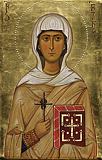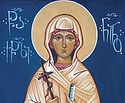

| Previous day | Next day |
| Old Style
January 14
|
Monday |
New Style
January 27
|
| 33rd Week after Pentecost. Tone 7. | No fast.
|
![]() Apodosis of the Theophany.
Apodosis of the Theophany. ![]() The Holy Fathers slain at Sinai and Raithu: Isaiah, Sabbas, Moses and his disciple Moses, Jeremiah, Paul, Adam, Sergius, Domnus, Proclus, Hypatius, Isaac, Macarius, Mark, Benjamin, Eusebius, Elias, and others (4th c.-5th c.).
The Holy Fathers slain at Sinai and Raithu: Isaiah, Sabbas, Moses and his disciple Moses, Jeremiah, Paul, Adam, Sergius, Domnus, Proclus, Hypatius, Isaac, Macarius, Mark, Benjamin, Eusebius, Elias, and others (4th c.-5th c.). ![]() St. Nina (Nino), Equal-to-the-Apostles, enlightener of Georgia (335).
St. Nina (Nino), Equal-to-the-Apostles, enlightener of Georgia (335).
St. Joseph Analytinus of Raithu Monastery (4th c.). St. Theodulus, son of St. Nilus of Sinai (5th c.). St. Stephen, abbot of Chenolakkos Monastery near Chalcedon (8th c.). St. Acacius, bishop of Tver (1567). St. Meletius, bishop of Ryazan, missionary to Yakutia (1900).
New Hiero-confessor John (Kevroletin), hieroschemamonk, of Verkhoturye (1961). New Martyrs slain at Raithu Monastery near Kazan: hieromonks Joseph, Anthony, Barlaam, Job, and Sergius, and novice Peter (1930).
St. Kentigern (Mungo), first bishop of Strathclyde (Glasgow), Scotland (612). St. Fulgentius, bishop of Ecija, Spain (632).
Repose of Nicholas Motovilov (1879), disciple of St. Seraphim of Sarov, and Hieromonk Cosmas, missionary to Zaire (1989).
Thoughts for Each Day of the Year
According to the Daily Church Readings from the Word of God
By St. Theophan the Recluse

Monday (32nd). [James 2:14–26; Mark 10:46–52]
What doth it profit, my brethren, though a man say he hath faith, and have not works? Can faith save him? (James 2:14).[1] The path to faith is repentance. In repenting what does one say? “I have sinned; I will not do it again. I will not sin; therefore I will live by the commandments.” Repentance does not depart with the acceptance of faith; but uniting with faith, it remains through to the end. So too this resolution to live by the commandments remains in force in the presence of faith. Consequently, if the believer came to faith along a direct path—that is, the path of repentance—he is zealous in fulfilling the commandments, or is a doer of good works. Faith gives him a most powerful motivation for this; faith also gives him grace-filled strength to accomplish this through the Holy Mysteries. Thus, faith furthers works. Works in turn make faith perfect, for until that which someone believes is done in deed, faith is not really faith. It becomes apparent only in works; not only apparent, but strong. Works influence back upon faith and strengthen it.
[1]Throughout the text, the King James Version will be used for New Testament quotes and allusions.
Articles
 St. Joseph Analytinus of RaithuSaint Joseph Analytinus of Raithu was a strict ascetic |
 Venerable Stephen the Abbot of Khenolakkos Monastery, Near ChalcedonSaint Stephen lived during the eighth century, and was born into a family in Cappadocia, who raised him in great piety. |







